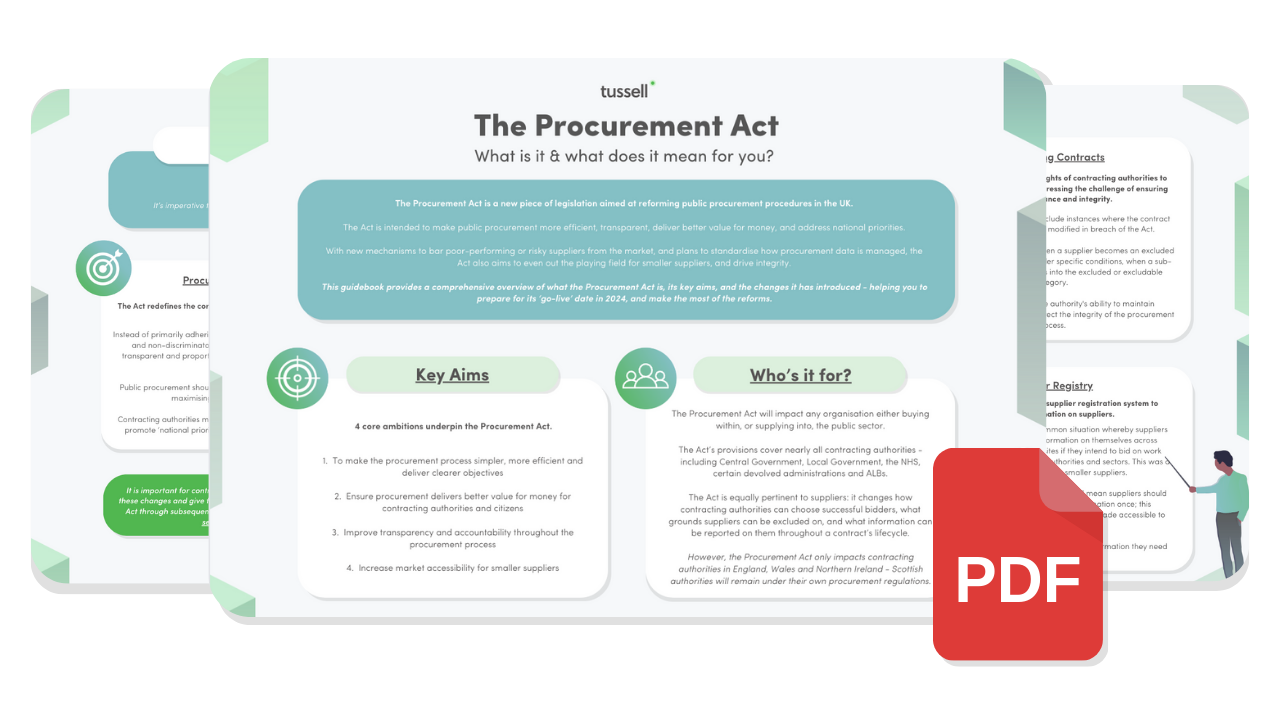On the 14th November 2022, the government released its Facilities Management Strategy for 2022-2030.
"This Facilities Management Strategy establishes, for the first time, a coordinated, cross-government vision for facilities management, setting the strategic approach and standards which will govern what good looks like and the quality of service which should be aspired to."
In this blog, we break down the FM Strategy to get to the crux of its aims, and unpack what it could mean for FM suppliers and SMEs operating in this sector.
If you're looking to sell more of your FM goods and services to Central Government, it is critical to have an understanding of the Strategy both when bidding on and delivering FM contracts.
Skip ahead to read about:
What is the purpose of this strategy?
At the heart of the Facilities Management Strategy is the government's intention to show it understands the importance of FM and the role that it plays in supporting public services and public policy.
Moreover, the government is seeking to portray FM as a cross-departmental policy area that requires a cross-departmental strategy - namely one that aligns with the overall Government Property Strategy's mission and ethos of transformation & sustainability.
These ideals are broadly set out in 'Facilities Management Standard 001: Management and Services' to be:
-
Alignment with objectives, needs and constraints of the organisation's core business
-
Focus on improving the effectiveness of, and benefits provided to the organisation by its facilities
-
Meeting the needs of all stakeholders
As a consequence of its inter-departmental nature, this Strategy will apply to all government departments and their ALBs, covering both the property these organisations hold or manage and properties that are held on their behalf.
The vision for 2030:
The government argues that through "the delivery of facilities management across government, the Strategy will create an estate which: Enhances Lives, Enables Success and Ensures Value, with accessible and responsive spaces, skilled professionals and quality services."
The Strategy breaks down each of these three core values into three goals:
|
VALUE |
GOAL |
|
Enhancing Lives |
1. Frontline delivery from accessible and responsive places. 2. Flexible and inclusive services in supportive workplaces 3. Sustainability at the forefront of all FM activities |
|
Enabling Success |
4. FM professionals equipped with effective skills and capabilities 5. Effective standards, tools, technology and organisation 6. Metrics that measure real-world performance |
|
Ensuring Value |
7. An holistic approach to asset management 8. Standardised and assured FM data and analysis 9. Assured FM contracts delivering quality service |
The key aims & their impact
The Strategy goes on to explain how it hopes to fulfil each of its core three values by 2025.
1. Enhancing Lives
-
FM organisations will have structures and resources that are effective in supporting public service reform i.e. hybrid working;
-
FM services will use an "appropriate mix" of internal and external services for design and delivery, as well as maximising the use of SMEs.
As a result, expect to see a variety of new organisational plans and management systems being introduced within the government to allow for a "one-team" approach to FM. This means that there is seamless coordination across all teams with a shared pool of resources, thus creating a "one-team" culture.
Alongside this, in order to deliver the Strategy the Government Property Function will adopt some existing legislation and protocols, including government FM standards FMS 001* and 002** by 2023. (You can find more about the existing government FM standards on the government website here).
-
Sustainability commitments are well-embedded into all aspects of FM including decision-making and maintenance plans
The Strategy sets out provisions for the development and maintenance of a Net Zero strategy and action plan for FM activities that will include the production of regular management information being shared as part of wider government net zero reporting. It is the aim of this Strategy that, with sustainability at the forefront of FM activities, positive environmental outcomes will be achieved and upheld.
2. Enabling Success
-
New investment in FM professionals
In order to achieve this, the Strategy sets out provisions for new requirements in relation to experience and accreditation for FM workers and a new FM secondment programme.
It is hoped that these new requirements will build on the existing career pathway for FM professionals and provide them with further support for more tailored learning and development than they currently have access to.
This upgraded pathway looks set to include FM apprentices and FM "Faststreamers". To see what the current career pathway in Government Property Profession looks like, click here.
-
Customer satisfaction improvement enabled through increased collaboration with FM delivery organisations
Building on the current FM standards will be the foundation of, and critical to, maintaining standards of FM delivery: a roadmap will be developed to help grow these standards into a strong standing framework that can be rolled out across the whole government creating continuing and increased quality.
-
More effective FM service delivery through the use of innovation and new technology
New and existing contracts will use technology to reflect the user experience through the compiling of data, and building systems to provide feedback. This innovation will be clearly stipulated within contracts and further frameworks and playbooks on FM.
-
Development and deployment of government-wide metrics for user experience, statutory and contract compliance
A playbook of FM delivery activities will be created containing all the associated resourcing guidelines thus creating a clear metric that will be useable government-wide without ambiguity. In practice, this aims to be a collection of maturity measurements and targets within Strategic Assest Management Plans (SAMPs). The role of SAMPs is "to help an organisation manager their infrastructure and other assets to an agreed standard of service."
3. Ensuring Value
-
Lifecycle replacement and maintenance decisions will include whole-life asset management methodologies
-
FM standard FMS 002 Asset Data implementation
A lifecycle approach for all buildings will be employed. This will include a condition survey at least every 5 years, a replacement profile every 30 years and a building maintenance and investment plan every 3 years - this will be informed by strategic asset management plans.
These lifecycles will also ensure that buildings are compliant with condition requirements of the already established standards of GovS 004 (the government functional standard for property).
-
Development of FM management organisations' data analysis capability
The Strategy sets out the need for a "Whole Life Asset Management toolkit" that will help to create and sustain all of the above stipulations in an effective manner.
Several admin and clerical changes will be implemented to achieve this value, including a named individual within each governmental organisation who will be responsible for FM data, as well as a building FM asset register that is compliant with existing FM Standards. Ensuring that each government organisation has in-house expertise on FM capability and decision-making processes is deemed critical, and will be fundamental in achieving this aim.
-
Assurance will be made across all government FM contracts through FM control and procurement processes
Importantly, a pipeline of all government FM contracts will be shared across all government departments to encourage collaboration and resource sharing. Additionally, consistent specifications for supplier and contractor job roles and qualifications will be established, making it easier for SMEs to successfully bid on these contracts.
It is the aim of this Strategy that the government will build on existing relationships with strategic suppliers and SMEs further when creating FM contracts. Alongside this, all central government FM contracts will be within the scope of the FM Control by the end of 2025. The FM Controls are operated by the Office of Government Property, Crown Commercial Services and Government Commercial Function with the aim and purpose of improving efficiency of FM through providing centralised approval of all new, extended or variations to FM contracts.
What does the strategy mean for FM suppliers in the public sector?
The FM Strategy hopes to bring some fundamental changes to how FM is delivered and operates within the heart of government. If you're looking to supply FM products or services to the government, it is key that you understand the technicalities of the Strategy and understand what it really means for you.
Suppliers will need to get their heads around how the FM Controls work as all FM contracts will fall into this by 2025. You can read the Controls in detail here.
Secondly, suppliers need to watch out for the new aggregated pipeline of all government FM contracts and the new specifications for supplier job roles and qualifications. Further information and details are expected to come from the government in the next few months.
Thirdly, we strongly encourage prospective suppliers to become well-versed in the FM Strategy and bear in mind is ambitions when curating bids for government FM work. Demonstrating an understanding and consideration for the government's overarching objectives could prove to be a valuable addition within your bid, and help you stand out against your competitors.
It is critical that if you want to do business with the government in the FM sector that you get your head around the frameworks and guidelines this Strategy suggests the government will be using more. Key documents include:
Further useful government documents include:
-
The Sourcing Playbook - looks at modelling, bid evaluation and risk & market management
-
The Construction Playbook - looks at supplier & supply chain engagement, net zero and sustainability in construction
Looking to the future...
The Facilities Management Strategy is a comprehensive document that incorporates many other existing government documents within the FM sector and other sectors such as construction.
It is important to bear in mind that this Strategy is just a strategy, and not law. This means that nothing within the new Facilities Management Strategy is legally binding unless it goes through the legislative process and is enacted into law - the Strategy as a whole is highly unlikely to go through this process as one complete Bill, but bits of the Strategy could well do.
Therefore, it is important to keep an eye on this Strategy over the coming months in order to monitor the developments and implementation of the Strategy's elements.
*
To find out more about the public sector FM market, check out our quarterly analysis of the public sector FM market with i-FM. This includes extensive details on a number of deals due to expire in the next 6-12 months.
Check out our recent FM Titans report - our list of the top 150 FM suppliers by public sector revenue in FY 2021/22. See who the market leaders are, who is buying the most and which frameworks you should be on.
Tussell's market intelligence platform is already being used by FM suppliers to track new FM opportunities, dig into their target accounts, see who their competitors are working with, and understand which frameworks they should get onto to win more work.
Book a personalised demo with our team to see how Tussell can unlock public sector insights and opportunities for your business.
*
*FMS 001 - "The aim of this standard is to improve quality, consistency and interoperability of facilities management (FM) services throughout the government estate. The key principle that informs this standard is that public sector FM organisations are first and foremost providers of FM services and must take full responsibility for the quality of the services they deliver."
**FMS 002 - "The aim of this standard is to improve the quality, consistency, interoperability and usage of facilities management (FM) asset data throughout the government estate. The key principle that informs this standard is that public sector organisations must be able to produce an asset register of all their FM assets and be aware of the condition and maintenance requirements of each asset."

















